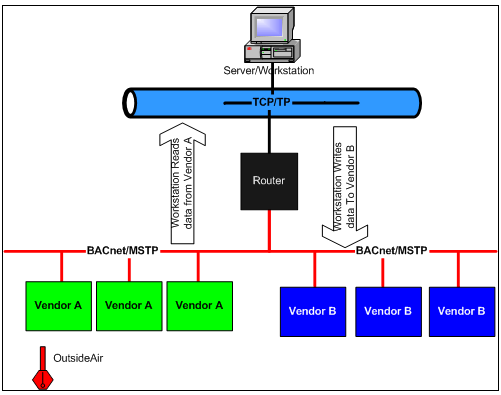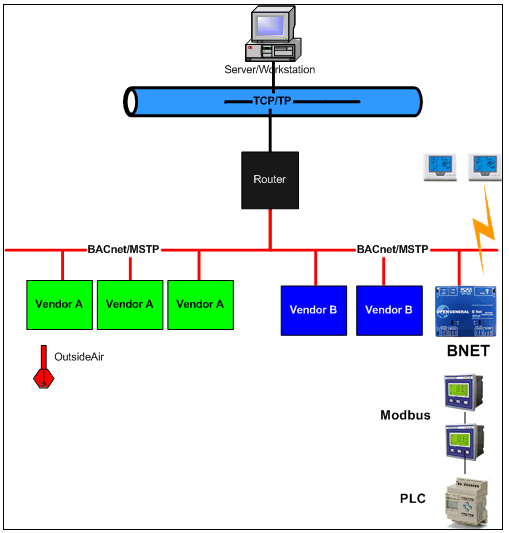May 2010
![]()
AutomatedBuildings.com
[an error occurred while processing this directive]
(Click Message to Learn More)
May 2010 |
[an error occurred while processing this directive] |
|
Also read the following sub-article |
|
Over the last decade web technology, information technology and open systems has been the key drivers in evolution of building management system. The drivers have opened up plethora of options for integration to improve performance of buildings. The combination of web, IT and open systems is improving the easy of use systems by delivering required information model to the correct audience. Web services, XML and Service Oriented Architecture are allowing easy data integration between multi-platforms, vendors and application. Just like many enterprise software organizations, building management system manufactures are following the web architecture model in developing their products.
|
|
|
|
|
|
|
|
|
|
|
|
|
[an error occurred while processing this directive] |
|
|
|
|
|
|
|
|
|
|
|
|
|
|
|
[an error occurred while processing this directive] |
But what is a web enabled building management system?
Is it the ability for the end user to monitor the system via the web? How easy
is it for the project engineer to create a web enabled system? How many
different software packages does the project engineer need to use make the final
end user system web enabled? Do you need to know HTML or JavaScript? Can you
program the controller via the web? Can you edit graphics via the web or do you
need stand alone application? These are some the common questions being asked to
define a truly web enabled building management system. Many vendors claim to
have web enabled system but in order to achieve the result many stand alone
applications must be used to generate the web pages. Due to the pressures of
releasing products to the market, many vendors are modifying their existing
legacy software to fit the web model. In terms of development and cost analysis
it is a beneficial approach but these software applications fail to utilize the
powerful web technologies available in the market.
Open General’s
OPENXpress is a web enabled BACnet based user interface designed from ground
up with fully integrated web application philosophy. The interface allows the
engineer to complete a project from start to finish using simple web browser.
From engineering, controller configuration, controller programming, generating
user graphics and to commissioning is performed via the web interface. There is
no requirement to generate web pages using stand alone application and then
download the pages to a web server. OPENXPress is a web server that the user
simply logs on via web browser to complete all the tasks in managing a building
management system.
The philosophy of designing a fully web enabled system is not only to take
advantage of the current web technologies available in the market but also to be
future ready with concepts such as cloud computing. Some key advantages behind
the web enabled system are as follows:
Cost reduction in software installation: A fully packaged web server is simply a plug and play device for the end user simply using their web browser. There is no requirement to install various software applications and database engines. This is not only a cost reduction for the end user but also for the support department.
Reduction in Learning Curve: A fully integrated web enabled package reduces the training time for end user. There is no need to learn two or three software tools but using integrated application all engineering tasks can be completed from a web browser.
Path to improve energy management: There have been enormous resources allocated to reduce energy consumption of buildings world wide. Government initiatives, green councils and many other bodies have been setup worldwide to promote the “Green” message. Building management system manufactures have joined on this green technology road to improve their product range, from improved energy calculation formulas to dynamic reporting tools. Consultants are specifying new methodologies to controls contractors to improve energy performance of building and these are been implemented in new and retrofitted buildings. But the question is, do the end customers who use the building see the end results of energy management actions? In majority of the cases, the answer to this question is NO. At present, the facility manger monitors the results but there is lack of feedback to the end customer who utilizes the building. The facility manger generally receives feedback from the building user when they are too hot or too cold. There is no feedback between facility manager and building user about how much energy did they use today and how it can be reduced. The facility manager has this information from the BAS, but in most cases the final link in the chain to improve energy performance of building is missing due to this broken feedback loop. The convergence of BAS and IT networks and a fully web enabled BMS is a path to improving this feedback loop. For example: a 20 story building with 4 clients leasing 5 floors each. With a web based system the each client in respective floors can access their respective daily energy profiles using web browser via the BMS from their desktop PC. Therefore the building users and management of each floor has a better understanding of how much energy they are using and can accurately allocate costs and assign responsibility to meet their energy key performance indicators. Also, say for example one client leasing the building is not comfortable using a BMS reporting tool, then with web integration the energy data for the user can be imported to a social networking such as Twitter for easy access. Similarly, most Enterprise Resource Planning (ERP) vendors are introducing energy reporting modules as part of the accounting system, therefore the data from the BAS can be imported to ERP system to fit requirements of the client. Therefore it be seen that using a web enabled system opens up many options to share data and report to the correct audience in the required format to assist in improving energy performance of buildings.
Design for Future: Emergence of cloud computing and software as a service (SaaS) becoming common model in the IT industry. A web based system designed using the right web technologies can be easily transformed to cloud computing model. Offsite data center served from cloud will provide better opportunities to manage real estate, reduction in capital expenditure and will open up value added propositions for buildings.
New technology will come and evolve and it is up to
the building system manufacturers to fully utilize the correct technology as an
enabler to improve their product range to improve performance of building
management systems.

The philosophy of the integration device is to obtain
required data from different vendors and protocols with minimum use of network
bandwidth.
Open system protocols have
transformed the building automation industry opening up endless possibilities
for system integrators and end users. Multi-vendor integration is driving the
industry today improving the competiveness of the market. BACnet has been a key
driver in open system protocol in the building industry allowing multi-vendor
integration. But at what level in the system architecture are we integrating the
data and what are the implications? How do we share data between two
multi-vendor BACnet devices? This article examines the two levels of
integration; software level and controller level and its implications.
Software Level Integration
The software level integration approach uses the main server/workstation
that resides in the IP layer as the main integration device, polling and writing
data to the required device. The software is used to integrate the devices. For
example as outlined in the diagram, the workstation polls for outside air
temperature from Vendor A and writes to Vendor B.

Read from Vendor A and write to Vendor B
The primary implication software level integration
method is the high network load on the workstation causing a bottleneck in the
system. Unnecessary data packets are flowing from MSTP to IP level and then back
from IP to MSTP level. The software application can have smarter algorithms to
minimize bandwidth but in a large site with many shared data points it’s
insufficient. Also, an offline server/workstation causes a failure in the
system. From a software engineering (developer) point of view, such an
integration method is the simplest in terms of implementation and testing due to
single point of control. As a result many vendors opt for such solution.
Controller level Integration
In controller level integration the data sharing between vendors is
completed at the BACnet/MSTP level without increasing bandwidth at the server.
Typical solutions involves the router reading data from Vendor A and forwarding
the information to Vendor B. Open General’s
BNET, Multi protocol gateway, extends this concept to share data between
different BACnet vendors and to convert other common protocols such as Modbus
and ZigBee to the BACnet backbone.

BNET obtains data from various protocols and medium and presents data in
BACnet network
The integration features of the BNET as follows:
The BNET resides on either BACnet/MSTP or at BACnet IP level for network optimization.
Data sharing between multi or same vendor at BACnet/MSTP level
Data sharing between multi or same vendor that resides on multiple BACnet networks. Data is routed through the routers that resides in the networks
Data share between BACnet/IP device and BACnet/MSTP device. For example many packaged unit air-conditioning organizations are introducing IP based BACnet gateways to monitor the units. In such case, if a particular data point from a unit is required by another BACnet/MSTP programmable controller, the BNET can obtain the data from the IP device and forwarded it to the MSTP device.
Obtain data from Modbus devices such as a PLC or energy meter and presents it in BACnet network
Obtain data from wireless protocols such as ZigBee and presents data in BACnet network
The BNET contains standard BACnet objects such as schedules, trend logs, alarms and programs which can be used with the data obtained from various sources.
[an error occurred while processing this directive]
The philosophy of the integration device is to obtain required data from
different vendors and protocols with minimum use of network bandwidth. It is
important to minimize traffic at low level protocols to improve the health of
the system. The BNET can be positioned at either IP or MSTP level depending on
the data sharing requirements to optimize the network design.
Open system protocols permit endless possibilities for data and multi vendor
integration. However, it is important to understand at what level the data is
integrating at and what is the effect of the integration method to the system.
With the continual convergence of BAS and IT networks, it is becoming even more
important for engineers and facility managers to understand how data is
integrated to have strategies in place to manage risks in the system.
About the Author
Nirosha Munasinghe is the product development manager and chief architect of building management system manufacturing company Open General. He is involved in research and development activities of BACnet based digital direct controllers, integration devices and web based user interface. Nirosha was awarded the Young Achiever of the Year 2010 for his contributions to the industry at the Australian Air-Conditioning Refrigeration Building Services Awards. He holds Masters in Business and Information Technology, Bachelors in Electrical Engineering and Computer Science from The University of Melbourne. Contact: nirosham@opengeneral.com
[an error occurred while processing this directive]
[Click Banner To Learn More]
[Home Page] [The Automator] [About] [Subscribe ] [Contact Us]